

How Seattle Got More People to Ride the Bus. Three experts in three very different positions weigh in on their city’s ridership success.

Almost every major U.S. city has seen years of decline in bus ridership, but Seattle has been the exception in recent years. Between 2010 and 2014, Seattle experienced the biggest jump of any major U.S. city. Whistler slashes bus fares, turns to public transit to beat congestion. Reducing congestion and lowering greenhouse gas emissions are high on the list of priorities for many municipalities around the province and, despite the high operating costs of public transportation, some have found cutting fares is key.
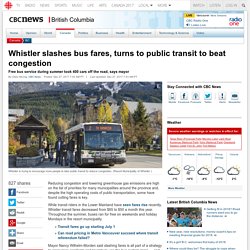
While transit riders in the Lower Mainland have seen fares rise recently, Whistler transit fares decreased from $65 to $50 a month this year. Downtown Columbus Will Subsidize Bus Rides For Workers - CityLab. Property owners in the Ohio capital's core are rethinking the relationship between cars and jobs.
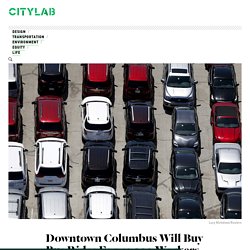
Despite a surge of redevelopment in downtown Columbus, office rents are tumbling and vacancy rates are on the up. The problem, business leaders say: Lack of parking. A structured parking space in the Ohio capital’s space-crunched core runs nearly $25,000 a year, which typically isn’t covered by revenues. So developers feel hamstrung from building new garages, and the city is wary of subsidizing them; building to meet parking demand, after all, is an exercise in futility. Meanwhile, employers fear they’re losing ground to suburban competitors. How to Future-Proof a Transit Hub - CityLab. How do you future-proof railway stations, metro hubs, and bus terminals?
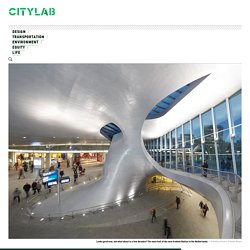
Architect Caroline Bos has a few pointers. What does the train station of the future look like? It’s a question that architects and urban planners must at least try to answer whenever they design new transit networks or terminals. The 3 Essential Ingredients for Cooking Up Transit That People Want to Ride – Streetsblog USA. This New “Mobility Service” App Will Help Helsinki Ditch Car Ownership. In Helsinki, it will soon be cheaper–and arguably more convenient–to subscribe to a new “mobility service” than own a car.

If you need to go somewhere, you pull up a new app, which calculates the best way to get there–public transit, a bike-share bike, taxi, a rental car, or a combination. Instead of buying individual tickets, you pay a monthly fee of €249. These New Transit Signs Could Save Chicago Billions of Dollars. You know how people say that we only use one-tenth of our brains?

This Electric Bus Recharges At Bus Stops In Just A Few Minutes. Americans have traditionally distinguished themselves from people in other countries by believing in Horatio Alger-type stories.
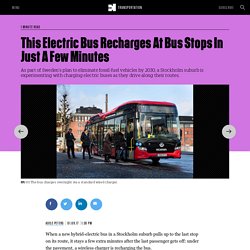
The nation was founded on the idea that anyone who works hard enough, and has enough talent, can make it here—and don't let anyone tell you otherwise. The Bluetooth-Enabled Wayfindr App Helps Riders With Visual Impairments Navigate Through Subway Systems. Wayfindr uses bluetooth “beacons” and audio navigation to guide users through labyrinthine stations.
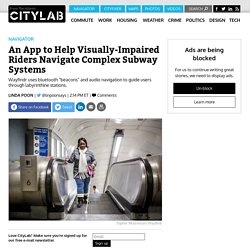
There’s a lot going in a subway station, with seas of hurried commuters rushing past one another to reach the many entrances and exits scattered around. For blind or visually-impaired riders, it can be intimidating to navigate around the chaos—and that can take a toll on their confidence in taking public transport and traveling independently. In fact, the Royal London Society for the Blind (RLSB) found that a quarter of the vision-impaired youth they surveyed were nervous about taking buses, trains, or the London Underground.
Over half didn’t feel confident about making transfers at transportation hubs. All sorts of innovation exists to instill that confidence, from 3D-printed maps to apps that rate the accessibility of different businesses. He also hopes to work with different organizations to bring the app to all kinds of indoor spaces, like retail stores. Nicolas Kruchten's Metro Map for Montreal's Green Line Puts Platforms First. Riders can easily determine the perfect place to await a train, relative to where they want to end up.
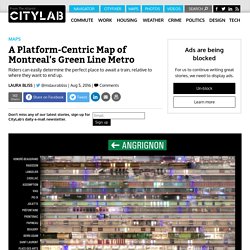
When you embark a train on an unfamiliar subway system, there’s rarely any way of knowing precisely where on the platform you’re going to wind up. Getting off the train almost always takes extra time and steps as you look for the right staircase or elevator. Each platform is a long scroll of repeating benches, poles, and system maps; there’s often little in these cavernous spaces to give you a clear sense of orientation. Now a clever software engineer has done some time-saving legwork to address that problem, at least for one city’s metro. The Train That Saved Denver. A decade ago, travelers arriving at Denver’s sprawling new airport would look out over a vast expanse of flat, prairie dog-infested grassland and wonder if their plane had somehow fallen short of its destination.
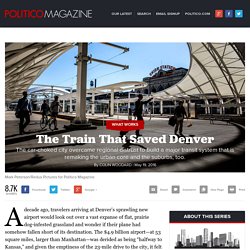
The $4.9 billion airport—at 53 square miles, larger than Manhattan—was derided as being “halfway to Kansas,” and given the emptiness of the 23-mile drive to the city, it felt that way. Last month, arriving visitors boarded the first trains headed for downtown, a journey that zips past a new Japanese-style “smart city” emerging from the prairie before depositing passengers 37 minutes later in a bustling urban hive of restaurants, shops and residential towers that only six years ago was a gravelly no man’s land—an entire $2 billion downtown neighborhood that’s mushroomed up around the hub of Denver’s rapidly expanding light rail system. Story Continued Below. Transport Reviews: How Transit Infrastructure Affects Propery Values. In transportation planning, the logic is pretty consistent: Build a rapid transit station, and land values are supposed to jump up. That’s because rail and bus rapid transit provide all kinds of benefits—reduced cost, time, and stress for commuters; cleaner air; more walkable neighborhoods—that can be translated into dollars and factored into property values.
Cities can “capture” this “land value uplift” to pay for transportation infrastructure projects (for example, by creating a special tax on certain developments that are projected to benefit most from the expanded transit access). This is the basic financing mechanism behind many recent major projects across the country, including Hudson Yards in New York City.
Making The Bus More Like an Uber With Real-Time Data and Mobile Payments. Mass transit usage rates across the U.S. have been stuck at around 5% for decades, but as cities grow, increasing that percentage is imperative to controlling congestion. This Interactive Visualization Explains the 'Vicious Cycle' of Bus Bunching. Good Public Buses Can Dramatically Reduce Employee Turnover for Local Business. Broadening the city through a universal fare card. » The Paris region plans a single monthly fare for transit access, eliminating zones for pass holders, with the dual goals of encouraging more transit use and social integration. San Francisco's All-Door Bus Boarding Program Has Been a Huge Success. She Tried Commuting to Work by Streetcar. It Took as Long as Walking. One of the big knocks on modern streetcars is that they exist primarily for tourists and not for everyday transit riders or commuters.
Rebecca Burns of Atlanta magazine (and our Future of Transportation series) put that question to the test last week on the city's newly opened 2.7-mile downtown trolley loop. Has the Streetcar Boom Reached the End of the Line? MTA buses will blare alert to warn pedestrians. 3 Big Challenges for Planning Multi-Modal Cities.
Cities of all sizes are reorienting their transportation priorities toward people over cars. Rebranding streets as "complete," "shared," or "great" reflects a turn away from automobility as the only choice for urban travel. Local transportation officials and planners now place a larger focus on offering many modes of travel and consider quality-of-life rather than simply encouraging driving everywhere. Overall, U.S. Streetcars Just Aren't Meeting the Standards of Good Transit. Since the U.S. streetcar revival relies heavily on transportation subsidies, it's only fair to expect the latest wave of streetcar lines to produce benefits related to (wait for it) transportation.
3 Big-Time Benefits of Real-Time Transit Data. Singapore's Early Morning Free Transit Program Has Been a Huge Success. Last week, Toronto mayoral candidate David Soknacki made a bold suggestion to improve the morning transit commute: offer free rides to anyone traveling before rush-hour. How Denver Is Becoming the Most Advanced Transit City in the West. The Rise of Private 'Luxury' Mass Transit Buses. The Colossal Expectations of D.C.'s Newest Metro Line.